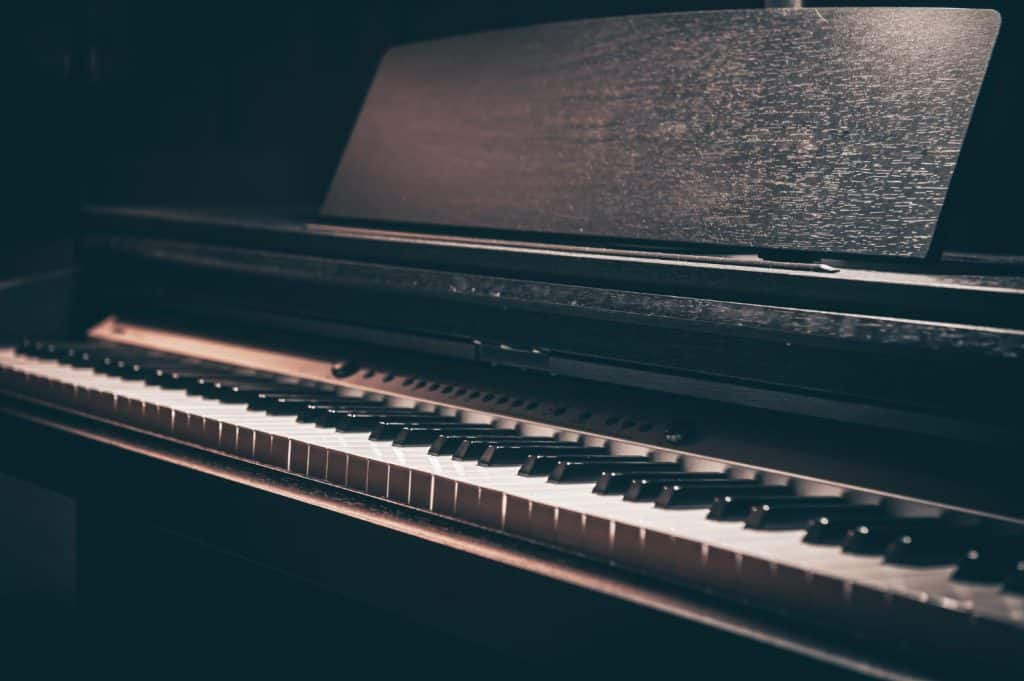Major and minor keys are concepts that are a very important part of music. Both major and minor piano scales have been used in music making in the western part of the world for hundreds of years.
Key signatures define which notes go together. They help to give music its character and emotion, and many people know that the difference between major and minor often comes down to the feeling of “happy” or “sad” in the music, with major keys feeling more positive and happy than minor keys.
This article will explain now only how they are related to one another, but how to play and write music using relative scales in any key signature.
- Fall in love with the music - Learn your favorite songs, at a level suitable for you.
- Enjoy interactive piano lessons - Explore courses covering music theory, technique chords & more.
- Get real-time feedback - Skoove's feedback tells you what went well and what needs practice.

What are the major keys on piano?
What are major and minor keys on piano? It is important to know that the “key” of music is not the same as the physical “keys” you press. In this article, when talking about minor and major keys we are talking about the collection of notes and chords that go together to make up a musical key, not the physical key you hit on the piano.
The major keys on the piano are the same as on every other instrument. The major keys are a huge part of music composition, and theory. Any note on the piano can be the start of a major scale or a major key. All we need to do is begin at a root note, and then apply our formula of the major scale from that root note. Major piano keys are also known as the Ionian mode or the first of the diatonic church modes.
Musicians also often call the first note of any major key “Scale Degree 1”, or the “tonic”. This is the first note in a major scale. This is an important concept to understand because in actuality, major and minor keys in piano are related to one another by scale degree. Having a strong understanding foundation of major keys allows all the other understanding of minor keys to be relatively simple because you can understand how they are similar.
The formula for a major scale
Root + Whole Step + Whole Step + Half Step + Whole Step + Whole Step + Whole Step + Half Step
This means that we can take any note, whether it is a white key or a black key and after applying this series of whole steps and half steps, you can work out the notes of a major key on the piano.
Pick an arbitrary note such as C# and follow this formula to work out the notes in the major scale.
What are minor keys on piano?
When wondering what minor keys on the piano are, you might think it is a totally different concept, when in fact minor keys are similar to the major keys on the piano.
In the same way, we can make a minor key on any note whether it be a white key or a black key, and then we apply a formula of whole steps and half steps after that root note. This allows musicians to make major or minor keys out of any specific set of notes, as long as they know exactly which pitch or “tonic” they are starting from.
However, in addition to thinking about minor scales as a root key and using a formula of whole steps and half steps following it, we can also think about major keys vs. minor keys relating to one another by thinking about scale degree.
Major keys and minor keys are complex, and it may take some time to get to the point where you memorize them, but they can be simpler when you know enough about how they fit together.
The formula for a minor scale
Root + Whole Step + Half Step + Whole Step + Whole Step + Half Step + Whole Step + Whole Step
We have introduced the concept of scale degree related to major scales, and identified the first note of this Major Scale as “1”.
Since major and minor keys are related to one another, if you play the same notes starting from scale degree “6” in a major key, and you have what is called the relative minor scale, or the scale created from the relative of the major key. These two keys share the same key signature and the same notes between the relative major and relative minor.
How major and minor are related
The best way to explain and demonstrate how major and minor scales are related is by using two piano scales and showing their relatives. To do this simply we will use for example the C Major and relative A Minor Key. These are the simplest to show because the key signatures don’t have either sharp keys nor flat keys, which means that both of them can be shown to be related to each other very clearly.
Two keys – same notes
The same notes that we use here in the C major scale have no sharps or flats, and the notes we use in the key of A minor are the same and have no sharps or flats. Notice how in both images there are no sharps or flats, and the numbers are related to the same notes for both keys.
C | D | E | F | G | A | B |
| 1 | 2 | 3 | 4 | 5 | 6 | 7 |
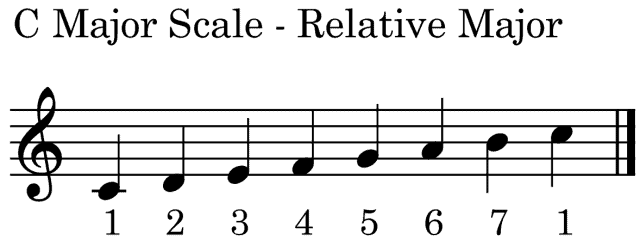
For the relative minor scale, the numbers remain the same but they begin with A. This is the difference between major and minor keys. The notes are the same, but the number relative to the scale degree remains the same between both. This is why we call them related. Relative keys share all the same notes, but not the same tonic.
| A | B | C | D | E | F | G |
| 6 | 7 | 1 | 2 | 3 | 4 | 5 |
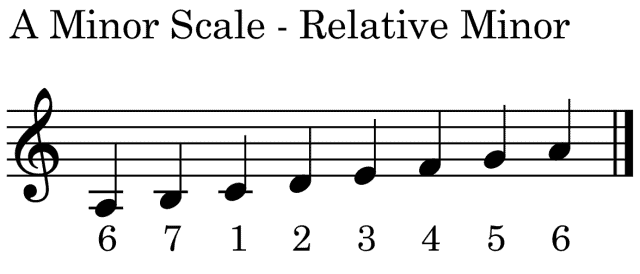
Minor key signatures
Minor key signatures give us the “sad” feeling and can be played simply by following a different pattern from the “tonic” note. You can start in exactly the same place as you would with a major scale but the intervals are different.
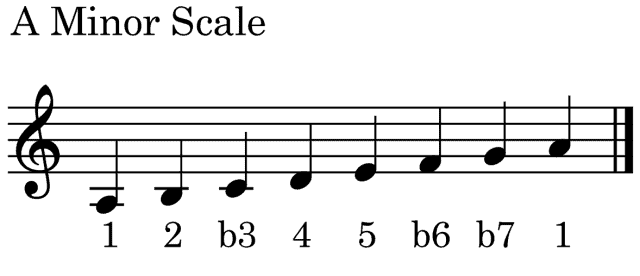
How to find the relative minor of a major key
Finding the relative minor of a major key is incredibly simple, as long as you know the key of the song.
This is how to make a minor key out of a major key, using piano intervals. For this example, we will use the key of G Major, with one sharp on F#. We start first at the note G, which is scale degree one in this key, and then we will walk down one-half step to the seventh note of the scale, and then down another whole step to the 6th note of the scale. With this one small tweak, you are now playing the relative minor key.
Major key signatures and minor can be very similar with just a few minor tweaks. With the right ear training you can learn to recognize the difference between major and minor keys and when.
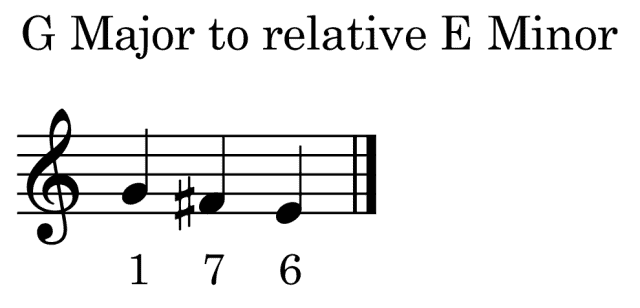
How to find the relative major of a minor key
To find the relative major to a minor key, we take the same concept that was introduced in the previous example and then reverse it. Instead of starting from scale degree one and working downwards into the relative minor key, we start at scale degree six and work our way up. We first play the root of our minor key, and then we realize that this note is scale degree six when compared to its relative major key.
Then we move up a whole step to scale degree seven, and then one-half step. We are now at the root of our relative major key. This is easy to do if you first know songs in a major key.
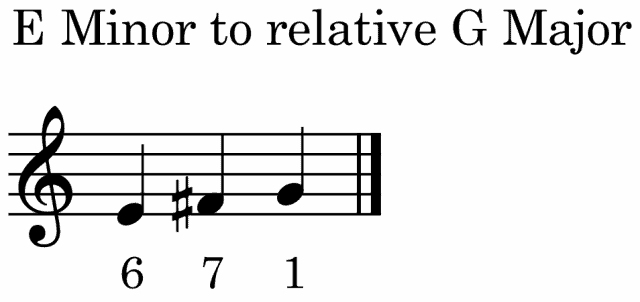
Changing between relative major and minor keys
To switch between these, you can just follow the example C major, and apply them to our major and minor song examples. To switch between these two keys we need only focus on scale degree one or scale degree six.
Once we alter from one to the other, we can play chord progressions relative to those chords as the focus of our progressions and melodies, and voila, we are playing in relative major or minor keys.
A musician who has these skills can experiment with songs in a minor key, changing minor to a major key, or major key to a minor key. Note that changing from major to relative minor is not the same as changing from major to parallel minor.
Why major keys sound happy
Typically songs in major keys do have a happy sound relative to them, this is often because the chord sequences resolve only to major chords, and they often are associated with happy examples of music.
Songs in major keys are often associated with triumph, celebration, and happiness, because of the subject matter they can convey and have historically. The idea that certain chords are naturally “happy” or “sad”, is actually just a characteristic that us humans have projected onto the notes and chords.
There is nothing inherent in any major key song that makes it “happy” or “sad”, but instead, because they are included in happy or sad subject matter, they take on the feeling of happy music.
Many songs written in the style of country, or upbeat jazz music may use only major key, but because their subject matter is often melancholy, the music is interpreted as being sad. Many songs will have both a major key and minor key present in the song, as the song modulates in the full version to the relative minor or major, proving that the happy and sad feelings have been added by humans.
Why minor keys sound sad
Similar to how major keys do not inherently sound happy because of the quality of the chords, minor keys are not sad by their nature, but sad by the association of subject matter that is contained within them.
Interestingly enough, a minor key also has some variations that can be used, examples of these include “natural minor”, or “harmonic minor scale”, or “melodic minor scale”.
These raised scale degrees create many different sound qualities compared to the diatonic scale, and interestingly enough the additional notes may create up to five different major chords in a minor key, whereas a major key will only have three.
The context within which music is played, the reasons it is played, how musicians use phrasing and inflection, and dynamics all help to create the emotions included in music. These can exist whether or not the songs are written in minor or major keys.
Examples of major and minor in music
Since every song is written in a key, there are lots of examples of songs that use both major and minor chords and scales. Skoove, of course, has lots of examples for you to learn, explore, and learn from.
Songs in the major key
Brahms – Lullaby
Featuring in Skoove’s beginner classical course, Brahms’ lullaby is instantly recognizable and in the key of C Major. It’s a great candidate for learning to recognize the sound and feel of a major, because it starts by playing a big C major arpeggio, and creates a beautiful atmosphere of calm and happiness.
Beethoven – Ode To Joy
Ode to Joy might be the single most major-sounding song in the Skoove library. Triumphant, proud, and a monument to Beethoven’s composition. Starting with three major chords, Ode To Joy represents the upbeat sound of a major key.
Songs in the minor key
Tchaikovsky – Sugar Plum Fairies Dance
Representing the complexity included in the minor key, the dance of the sugar plum fairies is from Tchaikovsky’s ballet, The Nutcracker.
Described earlier were the common variations included in minor keys and the addition of sharps and flats demonstrates the two other forms of minor keys. They sound wonderful here, dancing through bass lines and interesting chord substitutions.
Beethoven – Für Elise
Representing his minor key composition is Beethoven’s, Für Elise. The harmonic progression in this song is simple but effective, moving back and forth between minor and major chords in the key: A minor and E major.
Simplicity does not mean a lack of depth, and nowhere is that more clear than this incredible work, simplified for beginners in our beginner’s classical course.
Conclusion
Whether you’re writing, learning how to play piano, or learning to read music in a major or minor key, you now can readily change between the two with the knowledge that they are always only a few degrees apart. Whether by changing the entire major scale and altering it by using the scale degree, or by using the relative formula and moving between scale degree six or scale degree one, you now will have all the knowledge you need to play songs in major or minor keys and recognize and improve your skills.
Don’t think about it as major key vs minor key, or minor key vs major key, think about music as if they’re different sides of the same coin, and sometimes, a musician will use one or the other when composing. They are tools we can use as musicians. Just like the circle of fifths provides us an interesting way to work through all the twelve keys on a piano, and explaining provides an interesting way to practice music, the key signatures and their minor and major variations are crucial parts of the foundational knowledge of music.







